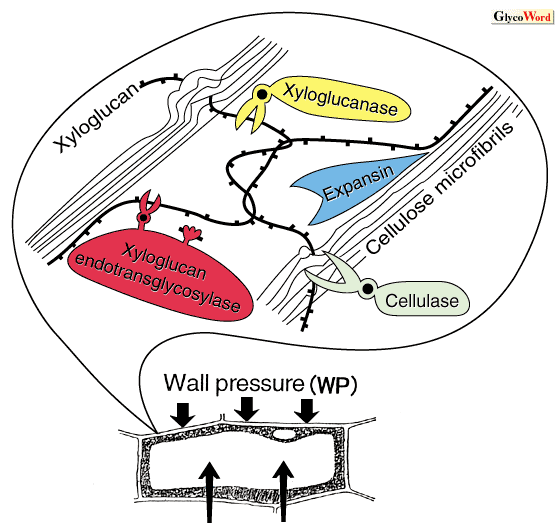|
Xyloglucan Oligosaccharides in Plant Cell Enlargement
|
 |
|
 |
The fucose-containing xyloglucan oligosaccharide inhibits synthetic auxin (2,4-dichlorophenoxy acetic acid)-induced elongation of pea stems, where natural auxin (indole-3-acetic acid) usually functions to promote cell enlargement during normal plant growth. The inhibitory activity is almost complete with the oligosaccharide concentration between 10-8 and 10-9 M, although synthetic auxin is required at the concentrations between 10-5 to 10-6 M. The function of the fucose-containing oligosaccharide is unknown but it may be involved in signal transduction, such as the induction of alpha-fucosidase activity. However, the mechanism of the inhibition of cell elongation is still unknown, i.e., the inhibition of cell elongation by the oligosaccharide with synthetic auxin has not been observed with natural auxin or in the presence of high concentrations (more than 10-7 M) of the oligosaccharide.
The cell elongation of pea stem is promoted by high concentrations (more than 10-6 M) of xyloglucan oligosaccharides. The promotion results in a decrease in cell wall viscoelastic properties. This may be due to the action of xyloglucan endotransglycosylase, which catalyzes the transfer of a newly generated reducing end from cleaved xyloglucan to the non-reducing end of the oligosaccharides. The overall reaction with xyloglucan endotransglycosylase and oligosaccharides causes xyloglucan degradation.
In summary, xyloglucan is degraded into oligosaccharides in growing plant cell wall, and the oligosaccharides provide either positive or negative feedback control during cell elongation.
Xyloglucan constitutes part of the wall of growing plant cells. The xyloglucans all possess a 1,4-beta-glucan backbone with 1,6-alpha-xylosyl residues attached to the 6-position of beta-glucosyl residues. Species-specific differences occur according to the distribution of additional branching galactosyl or fucosyl-galactosyl residues. Plant galactose-binding lectins can bind to the galactosyl residue and fucose-binding lectins to the fucosyl-galactosyl residue, but nothing is known about the function of the branching sugars. The 1,4-beta-glucan backbone can bind specifically to cellulose microfibrils by hydrogen bonding and extends the in vivo xyloglucan-cellulose network.
Auxin-induced xyloglucan solubilization begins within 15 min after auxin treatment of pea stems, and the effect not only increases with increased auxin concentration but also corresponds to the elongation rate. It has been reported that an antibody against xyloglucan prevents not only increase in xyloglucan degradation but also cell elongation. Potential enzymes involved in xyloglucan solubilization may be expansin, xyloglucanase, xyloglucan endotransglycosylase and cellulase.
Plant cell enlargement occurs due to the force of water suction, which is derived from the osmotic pressure of cell solutes. Water suction occurs due to the reduction of wall pressure, i.e. wall loosening. Although the mechanism of the loosening has not been clarified at the molecular level, auxin-induced cell enlargement has been proved to accompany xyloglucan degradation and solubilization. Studies on plant cell enlargement are beginning to reveal the mechanism of xyloglucan degradation in the wall of growing plant cells.
|
|
|
|
|
 |
 |
Fig. Mechanism of plant cell enlargement
A plant cell usually maintains cell size by wall pressure, by which the wall holds the cell which suctions water due to osmotic pressure (wall pressure  osmotic pressure). In the case of growing plant cells, auxin induces wall loosening, which also induces water suction, because the osmotic pressure becomes larger than the wall pressure (osmotic pressure > wall pressure). Water suction is the driving force of cell enlargement. osmotic pressure). In the case of growing plant cells, auxin induces wall loosening, which also induces water suction, because the osmotic pressure becomes larger than the wall pressure (osmotic pressure > wall pressure). Water suction is the driving force of cell enlargement.
|
|
|
|
|
|
Takahisa Hayashi (Wood Research Institute, Kyoto University) |
|
|
|
|
|
| References |
(1) |
T, Hayashi: Xyloglucan in the primary cell wall. Ann. Rev. Plant Physiol. Mol. Biol. 40, 139-168, 1989
|
|
(2) |
SC, Fry: Polysaccharide-modifying enzymes in the plant cell wall. Ann. Rev. Plant Physiol. Mol. Biol. 46, 479-520, 1995
|
|
(3) |
DJ, Cosgrove: Enzymes and other agents that enhance cell wall extensibility. Ann. Rev. Plant Physiol. Mol. Biol. 50, 391-417, 1999
|
|
|
|
|
|
| Mar. 15, 2000 |
|
|
|
|
|
|
|



